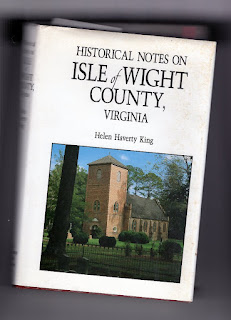The story of the biracial couple of 19th Century Isle of Wight, Virginia continues, written by Susan G. White (pictured right), a family historian known for her research and careful conclusions. We are grateful to her for sharing her insights and gathering information thoughtfully from the ancestors of this courageous couple. - Glenn N. Holliman
Enter Ann Gray, a White woman. Ann has been the subject of
much speculation and interest in current-day Holleman researchers. For generations, Black Hollemans have told of
Isaac and Ann’s complicated relationship in their oral history, that Isaac and Ann fled from her angry family in their initial love.
White Holleman researchers have tried to connect Ann with Gray ancestors who were closely connected with Josiah Holleman, or to other Ann Grays in Isle of Wight, but to no avail. Sandi Royal, a descendent of Isaac’s son Joshua, Denise Keeter Goff, an excellent Holleman researcher, and I worked hard this past summer of 2021 to track down Ann’s parents.
Sandi finally summed it up perfectly, “We will probably never know who Ann’s parents were.” Be that as it may, somehow, Isaac and Ann met and found a life together.
Above, Glenn N. Holliman and Sandi Royal discussing the Isaac and Ann Gray Holleman story in 2012 in Chester, Virginia.
We know of Isaac and Ann’s life first by way of Freedman’s Bureau records. Isaac petitioned the Freedman’s Bureau in October 1865, from Fort Monroe, Virginia, to request money for him, Ann, and his three children Robert, Ada, and Moses, to return to Nansemond county, Virginia, to “escape destitution.”
He also requested help from the Bureau that his son Robert Holleman be reimbursed for the money owed to him for working for the “Widow Binford.” Mrs. Binford and her husband lived one dwelling away from Malinda Pretlow in the 1860 Southampton County census. Isaac was working to get what he felt he was due after the war, in order to survive.
We can wonder how it was that Isaac, Ann, and
the 3 children ended up at Ft. Monroe? The fort was under Union
control during the Civil War, and commanded by General Benjamin Butler.
The general famously would not return slaves who
had fled to Ft. Monroe to Confederate owners; he called the slaves “contraband
of war.” Large numbers of slaves found the destination of Ft. Monroe
to be sanctuary, and we can guess that Isaac and family were no
different.
'The county was in desperate circumstances by
the end of 1863. The season had been bad, almost the entire slave
population was gone, the call came for more recruits for the army, the
insecurity of persons and property was made greater by frequent enemy
visits and there was a great scarcity of necessities for life on the home
front."
Isaac’s three children with his first wife Malinda Pretlow were Robert, Ada, and Moses, all who have been well documented. Robert married Cassandra Daughtry, and had 10 children; he stayed in the Isle of Wight area. Ada married Jacob Ely, and after she died, Jacob married her half-sister Lucerne Holleman, a daughter of Isaac and Ann. Moses married first Eugenia Randal/Randolph, and after she died, he married her sister, Ann Eliza Randal/Randolph.
Census records have been fruitful in uncovering Isaac’s story, with one exception. We cannot find Isaac and family anywhere in the 1870 census that would explain where they moved to after Ft. Monroe.
Why did they request transportation to Nansemond
county, southeast of Isle of Wight, instead of back to Isle of
Wight?
All comes well, though, in the 1880 census and
farm schedule, where Isaac, Ann, and family owned a 50-acre farm in the Windsor
district of Isle of Wight. They had a total of 10 children: Luzerne, Roxanna, or Roxie, Addie Lou, Nonnie
James, Isaac Thomas, Sr., Jeremiah, Joseph, Joshua Sr., John H. Sr., and
Joanna.
Recent examination of Isle of Wight land tax
records revealed that Isaac paid tax on his farm located 9 miles south of the
county courthouse until 1897, and we know that he fathered daughter Joanna,
also in 1897. His land entry was
entitled “Holleman, Isaac, estate” in 1898, so we can safely assume he died in
1897 or 1898. Ann shows on the 1900
census as a farmer, owning her home, and widowed. Further land tax
records continue to refer to the farm as Isaac’s estate.
This story of Isaac Holleman and his remarkable
life in Isle of Wight county, Virginia, shows resilience, persistence, and
honor in achieving his freedom in ways we find difficult to fathom.
He
survived slavery twice, gained emancipation, survived the Civil War,
Reconstruction, and Jim Crow. Isaac’s proximity to Fort Monroe,
Virginia and Isle of Wight, Virginia illustrate the geographical, political, and historical connections
of slavery in our Holleman family.
Isaac’s children’s stories continue, with
descendants Black and White uncovering and sharing them. Perhaps we
can share them later. -Susan G. White












No comments:
Post a Comment